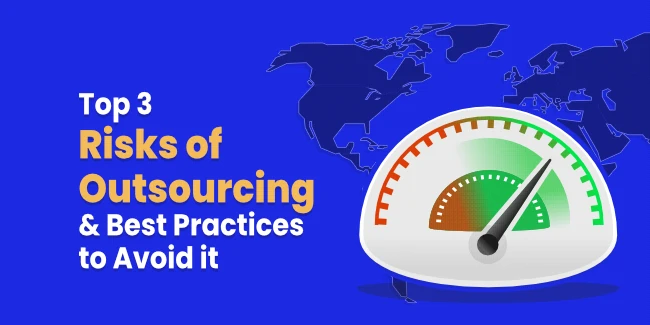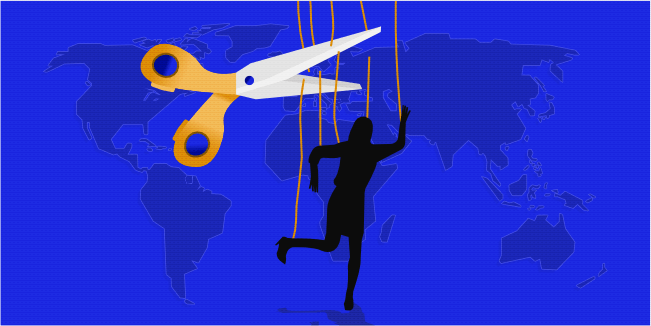outsourcing
risk
outsource
Top 3 Risks of Outsourcing & Best Practices to Avoid it

Outsourcing has many benefits, which is why it has become popular. For several years, outsourcing has been developing dynamically, and many new types of outsourcing are emerging, all to meet the expectations of customers from various industries. Eastern European countries stand out on the outsourcing map, including Poland, which has some of the best developers in the world. However, it is worth remembering that there are no perfect solutions, so IT outsourcing is also associated with certain risks.
Fortunately, you can recognize them and protect yourself from them. Certainly, the key to success is to entrust your project to a trusted software development partner.
In the article "Choosing the right software partner," we discussed how to complete this task and what to pay special attention to. Choosing the right partner will not only reduce the risk of outsourcing but will also guarantee the creation of a successful project.
Risks of Outsourcing
Outsourcing has numerous advantages that have made it famous, regardless of the industry. However, like any solution, outsourcing is also associated with various risks. It is worth knowing them because it will allow you to properly prepare for cooperation with an outsourcing company and avoid unpleasant surprises. This article will discuss the most common outsourcing risks and tell you what to do or avoid.
-
Loss of Control over the Project
Many companies that choose outsourcing services for the first time are afraid of losing control over their projects. It is due to the belief that if the service provider is based in another country or even on another continent, then both communication and supervision of the project will be much more difficult.

However, it is worth remembering that outsourcing is a highly flexible solution that adapts to customers' needs. There are many models of outsourcing so that everyone can find a solution that perfectly suits their needs.
Each outsourcing model is characterized by a different level of control because, contrary to appearances, this is an issue to which companies outsourcing their projects approach differently. Some companies want to be fully involved in the project and expect that every issue will be consulted with them. They want to know all remote team members and expect outsourcing providers to provide daily project updates.
Some companies do not have the resources or the need to work closely with an outsourcing firm. They outsource the entire project and expect it to be completed within the agreed-upon scope, time, and budget. Sometimes such companies are interested in, for example, a weekly update of work, but this is not a rule.
Of course, with such different approaches of companies to the issue of control over their projects, the key to success is cooperation with a proven outsourcing partner that can adapt to the expectations of a given client.
It is also crucial that, before starting cooperation, both parties sign a detailed contract to determine the scope of the project, budget, implementation time, and the terms of cooperation. Thanks to this, outsourcing risk in the form of losing control over the project will be almost nil.
-
Unforeseen and Hidden Costs
Outsourcing, by definition, is associated with the possibility of gaining market advantage through increased profitability and cost savings.
But if additional costs suddenly appear that were not included in the initial cost estimate, it may turn out that outsourcing will be unprofitable. No wonder many companies are afraid of unexpected costs, especially in the case of outsourcing software development, which is associated with significant financial outlays.

The risk associated with unforeseen and hidden costs seems terrifying. Still, contrary to appearances, it is easy to protect yourself against it. The critical issue is signing a service-level agreement, which defines the conditions for the service provided. SLAs are now considered a standard measure offered by IT companies and, in most cases, are concluded based on the client's individual needs. Therefore, when creating this type of document, it is essential to include in its content as many details as possible regarding the expectations and needs of the client regarding the website. Of course, this contract should also contain detailed provisions regarding payment terms, costs included in the cost estimate, and conditions regarding, for example, raising prices by an external company or issues relating to unforeseen costs. Analyze these records very carefully and assess how comfortable you feel with them.
Also, remember that when choosing outsourcing companies for cooperation, you should not be guided only by the low price. Unfortunately, it happens that the cheapest offers are only seemingly the cheapest because it turns out that they did not include many obvious services that other companies priced.
Therefore, before you decide to cooperate with an external supplier, read the opinions about a given company, preferably on a website that not only publishes references but also checks their credibility (e.g., clutch.co).
When a company outsources its project implementation, it involves transferring much data about the company and its business. Data leaks are dangerous; many companies fear transferring data to third parties. Privacy and security concerns often block companies from using outsourcing services. For this reason, outsourcing companies do everything to ensure that the data entrusted to them is safe. They pay particular attention to privacy, intellectual property, and data protection. Remote teams in good external companies are adequately trained to prevent data leakage.
The risk related to data security can be further minimized by concluding an NDA (non-disclosure agreement) with an external supplier.
The contract should include the specification of confidential information, obligations of the parties, sanctions for breach of the contract, including contractual penalties, duration of the confidentiality obligation, and the rules for returning data carriers after the end of the contract. The NDA is now standard; any responsible outsourcing provider will sign it. If the supplier does not agree to such a contract, it signals that your data may not be adequately protected. Therefore, find a partner in software development that will ensure the security of your most valuable resources, i.e., data.
Conclusion
Outsourcing is still the best way to implement a successful project at lower costs. Don't let the vision of risks stop you from supporting the development of your company.
The risks associated with outsourcing are obvious, and it is easy to prepare for them. Of course, that doesn't mean you can ignore them. On the contrary, awareness of certain risks and the need to take appropriate steps make companies treat them with appropriate seriousness. And if you entrust the implementation of your project to a trusted outsourcing company, you can count on a successful project and a maximum risk reduction.